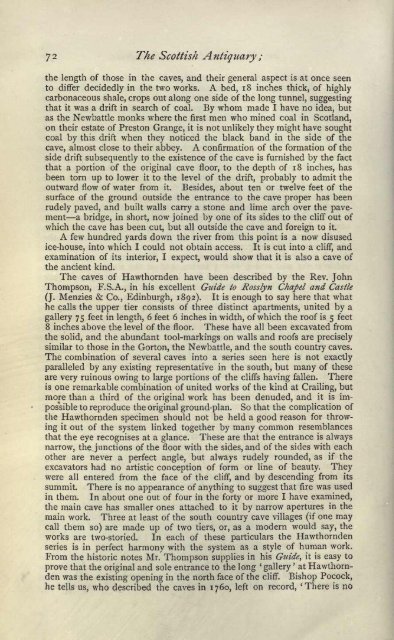You also want an ePaper? Increase the reach of your titles
YUMPU automatically turns print PDFs into web optimized ePapers that Google loves.
72<br />
The Scottish Antiquary ;<br />
the length of those in the caves, and their general aspect is at once seen<br />
<strong>to</strong> differ decidedly in the two works. A bed, 18 inches thick, of highly<br />
carbonaceous shale, crops out along one side of the long tunnel, suggesting<br />
that it was a drift in search of coal. By whom made I have no idea, but<br />
as the Newbattle monks where the first men who mined coal in <strong>Scotland</strong>,<br />
on their estate of Pres<strong>to</strong>n Grange, it is not unlikely they might have sought<br />
coal by this drift when they noticed the black band in the side of the<br />
cave, almost close <strong>to</strong> their abbey. A confirmation of the formation of the<br />
side drift subsequently <strong>to</strong> the existence of the cave is furnished by the fact<br />
that a portion of the original cave floor, <strong>to</strong> the depth of 18 inches, has<br />
been <strong>to</strong>rn up <strong>to</strong> lower it <strong>to</strong> the level of the drift, probably <strong>to</strong> admit the<br />
outward flow of water from it. Besides, about ten or twelve feet of the<br />
surface of the ground outside the entrance <strong>to</strong> the cave proper has been<br />
rudely paved, and built walls carry a s<strong>to</strong>ne and lime arch over the pavement<br />
a bridge, in short, now joined by one of its sides <strong>to</strong> the cliff out of<br />
which the cave has been cut, but all outside the cave and foreign <strong>to</strong> it.<br />
A few hundred yards down the river from this point is a now disused<br />
ice-house, in<strong>to</strong> which I could not obtain access. It is cut in<strong>to</strong> a cliff, and<br />
examination of its interior, I expect, would show that it is also a cave of<br />
the ancient kind.<br />
The caves of Hawthornden have been described by the Rev. John<br />
Thompson, F.S.A., in his excellent Guide <strong>to</strong> Rosslyn Chapel and Castle<br />
(J. Menzies & Co., Edinburgh, 1892). It is enough <strong>to</strong> say here that what<br />
he calls the upper tier consists of three distinct apartments, united by a<br />
gallery 75 feet in length, 6 feet 6 inches in width, of which the roof is 5 feet<br />
8 inches above the level of the floor. These have all been excavated from<br />
the solid, and the abundant <strong>to</strong>ol-markings on walls and roofs are precisely<br />
similar <strong>to</strong> those in the Gor<strong>to</strong>n, the Newbattle, and the south country caves.<br />
The combination of several caves in<strong>to</strong> a series seen here is not exactly<br />
paralleled by any existing representative in the south, but many of these<br />
are very ruinous owing <strong>to</strong> large portions of the cliffs having fallen. There<br />
is one remarkable combination of united works of the kind at Crailing, but<br />
more than a third of the original work has been denuded, and it is impos'sible<br />
<strong>to</strong> reproduce the original ground-plan. So that the complication of<br />
the Hawthornden specimen should not be held a good reason for throwing<br />
it out of the system linked <strong>to</strong>gether by many common resemblances<br />
that the eye recognises at a glance. These are that the entrance is always<br />
narrow, the junctions of the floor with the sides, and of the sides with each<br />
other are never a perfect angle, but always rudely rounded, as if the<br />
excava<strong>to</strong>rs had no artistic conception of form or line of beauty. They<br />
were all entered from the face of the cliff, and by descending from its<br />
summit. There is no appearance of anything <strong>to</strong> suggest that fire was used<br />
in them. In about one out of four in the forty or more I have examined,<br />
the main cave has smaller ones attached <strong>to</strong> it by narrow apertures in the<br />
main work. Three at least of the south country cave villages (if one may<br />
call them so) are made up of two tiers, or, as a modern would say, the<br />
works are two-s<strong>to</strong>ried. In each of these particulars the Hawthornden<br />
series is in perfect harmony with the system as a style of human work.<br />
From the his<strong>to</strong>ric notes Mr. Thompson supplies in his Guide, it is easy <strong>to</strong><br />
prove that the original and sole entrance <strong>to</strong> the long '<br />
gallery '<br />
at Hawthornden<br />
was the existing opening in the north face of the cliff. Bishop Pocock,<br />
he tells us, who described the caves in 1760, left on record, 'There is no

















